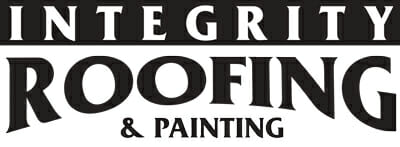How are class 4 shingles rated?
Shingles are rated for their ability to resist hail damage. The class 4 shingle is the one that will be highlighted in this post. Each manufacturer has shingles on the market that have been tested and rated by underwriters’ laboratories using specific units of standards and testing measurements that qualify as hail impact resistant shingles.
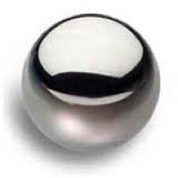 The first rating is a Class 1 shingle that has passed a test with a 1-1/4” steel ball dropped from 12 feet. The roof shingle must be struck twice at the same target area without damaging the mat. Today all composition shingles are made with a fiberglass mat, therefore the fiberglass mat is inspected for visible damages. At one time shingles were made with organic mats. These products failed continually. A fiberglass mat has proven to be a more sustainable effective product. This steel ball must hit the field area of the shingle two times and the edge of the shingles two times without damaging the mat to qualify for a particular class rating. Class 1 would be the lowest tested rating.
The first rating is a Class 1 shingle that has passed a test with a 1-1/4” steel ball dropped from 12 feet. The roof shingle must be struck twice at the same target area without damaging the mat. Today all composition shingles are made with a fiberglass mat, therefore the fiberglass mat is inspected for visible damages. At one time shingles were made with organic mats. These products failed continually. A fiberglass mat has proven to be a more sustainable effective product. This steel ball must hit the field area of the shingle two times and the edge of the shingles two times without damaging the mat to qualify for a particular class rating. Class 1 would be the lowest tested rating.
The next class asphalt shingle is a class 2 shingle. This shingle has to pass a 15 foot drop of a 1-1/2” steel ball with repeated hits on the field and edge two times with no damage to the fiberglass mat. These shingles are found on roofs throughout our region.
The class 3 shingle is tested with a 1-3/4” steel ball and dropped from a height of 17 feet. You’ll find that the shingle on your home may be a class 3 shingle. These are commonly found to have approximately a 30 year limited lifetime offering. They stand up well to small hail but not to larger hail that is sometimes experienced in Colorado.
The Class 4 Shingle
Currently the highest class of asphalt shingles is the class 4 shingle which will carry at least the U.L. 2218 steel ball listing. I’ll share on several test that can be performed in this category for the highest performing impact resistant shingles on the market today. This product is of great interest to insurance companies and homeowners alike. I’m hoping to see greater test and shingle changes in the future to create a class 5 product. Only time will tell. The class 4 shingle is tested with a 2” steel ball that strikes the same area twice. This ball is dropped from a distance of 20’. The class 4 product must show no evidence of punctures, tears, cracks, splits, ruptures on top or bottom. In addition, this product will be observed with 5x magnification to ensure that it has passed the test.
Are There Any Other Tests Available to Determine Class Rating?
Another test that is sometimes used is the ice ball test which began in the year 2000. The ice balls are propelled to match the same speed as a free falling ice stone of the same size. This test requires that the targeted area on the shingle is impacted 3 times as opposed to the steel ball test of only 2 times. This is a pass or fail test. To pass this test, the shingles must show no immediate visual evidence of compromise to the fiberglass mat.
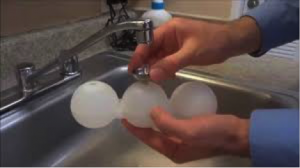
A comprehensive test that many manufacturers do not use, but may be the best test is the UL2218 B-ice hail impact resistant test. This is an aggressive test that involves wrapping the repeatedly impacting shingle around a 4 inch pole for examination. This test will reveal any ruptures, fractures, tears or cracks in the shingle. The shingle is first impacted by ice balls launched at free fall speeds and that are 2” in diameter in order to pass a class 4 rating.
We will see changes in testing and classifications of shingles in the future. Please note that no one manufactures a residential hail proof roof. However we seriously recommend considering a class 4 hail impact resistant shingle.
Functional Damage to Shingles
In a previous blog, I mentioned functional damage of a roof system, and I’d like to expound on that briefly. It is important to clarify that when a hail stone impacts a roof system it may or may not damage it. For instance if you’ve recently installed a class 4 hail impact resistant shingle on your home and your roof was impacted by 2-1/2” hail stones, there is a chance that your roof sustained no functional damage. However, if your roof is made up of a 10-year old class 4 shingle it probably did sustained damage. I’ll share more on this in a moment, but for now let’s describe what is functional damage and why.
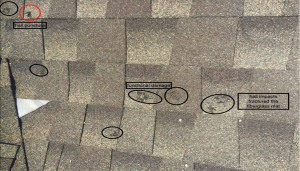
There are two aspects of Functional damage that I will address in this blog. The first type of functional damage is caused from an ice impact created from a thunderstorm impeding the roof system’s ability to shed water. Additionally, functional damage is described as the loss of life expectancy of the roof system. Both definitions of functional damage may be present on the roof.
However, if only one definition of functional damage applies to a roof system, then it would likely be the loss of life expectancy of the roof system. When identifying the diminutive ability of the roof to shed water, tears and punctures will be present on the roof system.
A Current Example of Functional Damage
From the recent storm in Highlands Ranch we’ve inspected some roof shingles that have been torn or have sustained small punctures. The photo above is from Highlands Ranch and many Denver roofers have seen what you can now see. This image illustrates all of the areas on the shingles that were impacted by hail. Many more of the roofs that we have inspected had fiberglass mats that were bruised and had small fractures from hail stones which have decreased the serviceability of the roof system. Whether there were punctures or only bruises, these roof systems should be replaced.
Effects of Aging on a Class 4 Roof
Older class 4 roof systems can sustain damage from 2-1/2” stones. As asphalt ages it becomes less pliable and more brittle. As a result, it no longer has the ability to transfer impact energy and the mat is damaged and/or punctures occur to this system. Most insurance companies recognize this and only recognize a class 4 shingle to provide a measure of protection for only a decade or less. Class 4 shingles are great, but again they are not hail proof and their serviceability diminishes over time. Nevertheless, I highly recommend installing a class 4 asphalt shingle.
What About Metal Class 4 Roofs?
In most cases, I will not recommend installing a class 4 metal roof system. Many insurance carriers have clauses in their property coverage pertaining to metal roofs which state that they don’t owe for cosmetic damage to a metal roof system. This photo shows cosmetic damage which is highly visible from the ground. We took this photo from the ground level. If a hammered metal roof is the desired look that you were longing for, then you’ll be pleased with the hail hits on your metal roof system. In most cases it would take baseball sized hail to create functional damage to a steel panel. In some instances it would take larger than softball sized hail to puncture the panels or to break loose the seams. Metal roofs are durable, but the flip side to this is that you could be stuck with an ugly, dinged up roof if the metal doesn’t sustain large enough damage for it to be replaced.
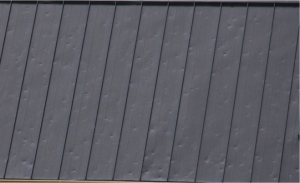
Imagine spending $60,000 for a steel roof and having it dented to the point of being able to view it from the ground, yet it doesn’t have any functional damage required by an insurance company to be replaced. The homeowner should not be surprised when an insurance adjuster denies a claim based on the policy stating that they do not owe to replace the steel roof panels or stone coated steel without real functional damage. It is advisable to read the policy carefully when considering investing in a metal roof system.
Many overzealous roof salesmen would disagree with me and even misrepresent the facts to the homeowner to try to earn business and upsell a more expensive roof. We understand and agree with the definition of functional damage. Several team members of Integrity Roofing and Painting have training from Haag Engineering and can provide additional information to anyone considering a metal roof.
Should I Invest in a Class 4 Shingle System?
If you live in an area prone to repeated hail storms like Colorado, it is definitely worthy of consideration. Integrity Roofing and Painting is a Denver Roofer that is able to install a class 4 rated roof system. Please contact us if you’d like more information about a hail impact-resistant shingle. The cost of an upgrade could be less than a future deductible and could save you from the time investment in having to replace a roof again soon. Most insurance companies offer a discount on premiums for a Class 4 roof, which makes it more appealing. Over time you can recoup your initial investment. Call your agent to find out how much of an annual discount you can receive and weigh that against the cost of the upgrade and future deductible payments. Even if you are selling your home soon, it would be a great selling point to attract buyers. You may find that this is a great opportunity for you!
Please keep in mind that a Class 4 Hail Impact Resistant roof is NOT a Hail Proof Roof. That does not exist on our current residential market. We have replaced Class 4 roofs that were still considered new after a large hail storm. If the hail is large enough, falls hard enough and long enough, you may still be replacing your roof. The insurance company, however, would then cover a class 4 roof replacement as it would be there responsibility to replace what is present on your current roof. This means that you would not have the cost of an upgrade at that point as it would be a onetime investment. Only you can decide if it is the right investment for you, but from our experience, we do stand behind the recommendation of installing an asphalt Class 4 Roof.
Contact a Denver Roofer for Help with a Class 4 Roof
As a Denver roofer, Integrity Roofing and Painting regularly installs class 4 roof systems. Contact us today. We make roof replacements easy!
